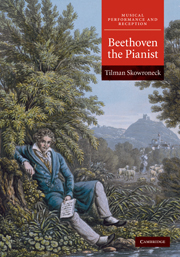Summary
The main topic of this book has been the confrontation between old and new in Beethoven's world. The old shows itself in Beethoven's relationship to his teachers and to the traditional musical practices of his time. Although we know very little about Beethoven's opinion of various stylistic conventions from the time of his upbringing, many notational details do link his practice to his teachers Neefe and Haydn, and to keyboard methods such as Marpurg's or Bach's. And even when he wrote “new” music, his communication with his customers and audiences had to rely on tradition; his expressive notation was conventional most of the time, even when his music was not.
Old and new define Beethoven's piano playing as well, although in a much more problematic sense. “New” in Beethoven's playing was what was still fresh in the memory of his contemporaries and first biographers. This is the decline of his pianistic abilities, which made a clear and lasting impression and has shaped the image of Beethoven the pianist until the present day. This circumstance has obscured the “old” element of his playing: the qualities as a pianist that he might have had during his first decade in Vienna, when he was at the height of his powers and performed frequently.
Finally, his opinion of various types of pianos would also have addressed both old and new, had it not been shaped by his ever more problematic relationship to piano playing on account of his deafness.
- Type
- Chapter
- Information
- Beethoven the Pianist , pp. 260 - 262Publisher: Cambridge University PressPrint publication year: 2010



